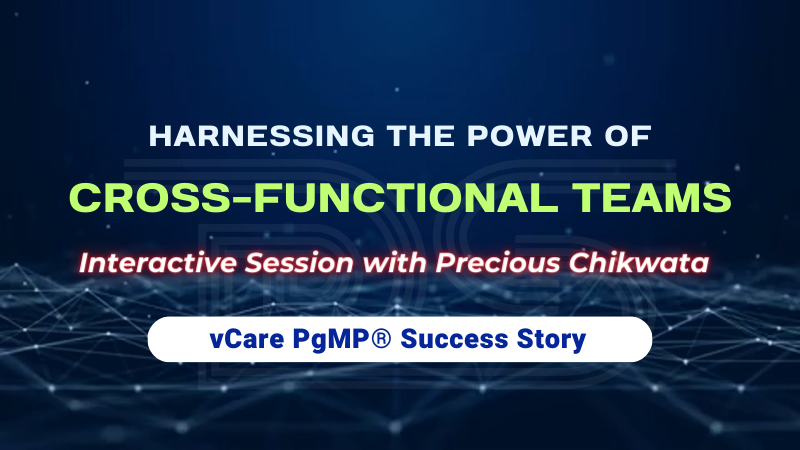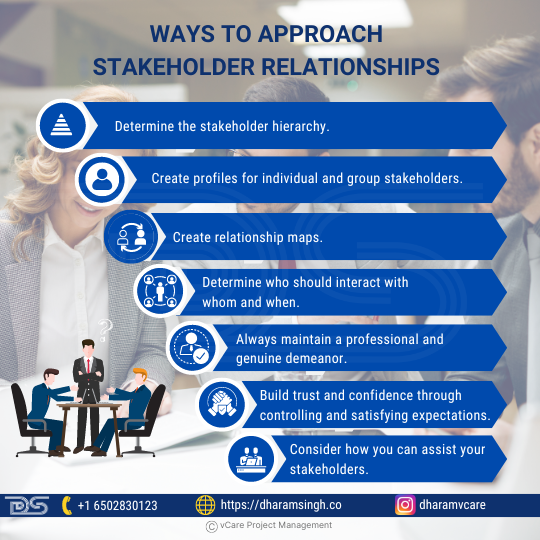
by Dharam CW2 | Apr 30, 2024 | Project Management
Stakeholder Relationships
In project management, having strong relationships with stakeholders is critical to success. As someone who has mentored thousands of PMP, PgMP, and PfMP professionals, I have seen firsthand how strategic stakeholder engagement can transform project outcomes.
Ways to approach Stakeholder Relationships
Below are some essential strategies for building and maintaining these crucial relationships:
1. Map the territory: Understand the stakeholder hierarchy and create detailed profiles for individual and group stakeholders.
2. Design relationship pathways: Use relationship maps to illuminate interactions, thereby ensuring timely and effective communication.
3. Consistency and integrity: Always interact with professionalism and authenticity, building trust through reliability and ethical behavior.
4. Meet and exceed expectations: Foster trust and bolster confidence by managing and surpassing stakeholder expectations, committing to your promises, and maintaining transparency.
5. Support to succeed: Focus on how you can support stakeholders in ways that benefit project goals, enhancing mutual success.
Let’s share our ideas on personalizing our approach to stakeholder management and take our projects to new heights of success.
🚀 Elevate Your Project Management Career:
– Register for my upcoming PgMP/PfMP Success Story Webinar: https://bit.ly/3TSx8fj
– Book an obligation-free consultation session on Project management Career, training, and certifications: http://talktodharam.com
– Discover training offers and certification discounts: https://bit.ly/3jWVepD
– Stay updated with our Q&A series and certification success stories by subscribing to the vCare Project Management YouTube channel at https://bit.ly/2YF0wJl
– Follow my podcasts and interviews with Project Management Experts on YouTube at https://bit.ly/2NDY8wd

by Dharam CW2 | Apr 10, 2024 | Project Management
Join Thomas Walenta, a renowned Global Project Economy expert, and myself in Episode 62 as we delve into the transformative world of projectification. We’ll unravel how the evolution towards a “project society” reshapes industries. This episode explores the ripple effects of projectification on innovation, digital progression, and the global market landscape. We’ll discuss the dynamic shift towards more agile and flexible work arrangements, the dual-edged sword they present, and the broader societal impacts that extend far beyond project completion.
Engage with us as we challenge the traditional “Business as Usual” model and dissect the evolving roles of PMOs in stable and dynamic organizational contexts. This insightful dialogue, where we share unique perspectives on the topic, is not just about information but sparking thought and discussion on how projectification influences businesses and society.
Don’t miss out on this crucial discussion that is shaping the future of work and societal development. It’s a conversation you need to be a part of. Watch now: https://youtu.be/7IXgqFQc23w
🚀 Seize the opportunity to Elevate Your Project Management Career:
– Register for my upcoming PgMP/PfMP Success Story Webinar: https://bit.ly/4bzs0U6
– Book an obligation-free consultation session on Project management Career, training, and certifications: http://talktodharam.com
– Discover training offers and certification discounts: https://bit.ly/3jWVepD
– Stay updated with our Q&A series and certification success stories by subscribing to the vCare Project Management YouTube channel at https://bit.ly/2YF0wJl
– Follow my podcasts and interviews with Project Management Experts on YouTube at https://bit.ly/2NDY8wd

by Dharam CW2 | Apr 2, 2024 | Program Management, Uncategorized
Join Justin Buckwalter, PfMP, PgMP, PMP, PMI-ACP, PMI-RMP and me in our latest episode as we explore the transformative journey “From Program Managers to Changemakers.” We discuss how program managers can evolve into forces of change, leading projects and teams toward impactful innovation. We also differentiate the roles of change managers and changemakers and uncover the strategies that drive successful organizational transformation. Additionally, we delve into the significance of the Agile Manifesto for changemakers and how they emerge as next-generation leaders in a VUCA (volatile, uncertain, complex, ambiguous) world. This episode is a must-watch for those ready to lead change and inspire their teams to do the same.
🔗 Watch now: https://youtu.be/QO4oR_wuZ0E
🚀 Elevate Your Project Management Career:
– Register for my upcoming PgMP/PfMP Success Story Webinar: https://bit.ly/3wEcztT
– Book an obligation-free consultation session on Project management Career, training, and certifications: http://talktodharam.com
– Discover training offers and certification discounts: https://bit.ly/3jWVepD
– Stay updated with our Q&A series and certification success stories by subscribing to the vCare Project Management YouTube channel at https://bit.ly/2YF0wJl
– Follow my podcasts and interviews with Project Management Experts on YouTube at https://bit.ly/2NDY8wd

by Dharam CW2 | Mar 21, 2024 | Professional Development Webinars
Dive deep into the PMI’s latest enhancements to the Program Management Professional (PgMP)® credentials, tailored for senior project, program, and portfolio management professionals.
Registration Link: https://bit.ly/4c9un0j
Session Date : 26th March 2024
Session Time : 10:30 AM – 11:30 AM (PDT) / 11:30 AM – 12:30 PM (MDT) / 12:30 PM – 01:30 PM (CDT) / 01:30 PM – 02:30 PM (EDT) / 02:30 PM – 03:30 PM (BRT) / 05:30 PM – 06:30 PM (GMT) / 06:30 PM – 07:30 PM (CET) / 07:30 PM – 08:30 PM (SAST) / 08:30 PM – 09:30 PM (AST) / 09:30 PM – 10:30 PM (GST)
Webinar Agenda
– Simplified Application Insights: Grasp the updated application’s simplicity, from reduced experience summaries to a wider panel expediting reviews.
– Revised Standard for Program Management: Unpack the 5th Edition’s eight principles, spotlighting Stakeholders and Governance to elevate global program practices.
– Aligned Exam Content: Decode the subtle yet vital changes in the exam outline mirroring the new standard’s language.
– Exclusive PMI Membership Perks: Uncover the benefits, including complimentary access to crucial PMI standards, bolstering your certification pursuits.
– Industry Expertise & Dialogue: During our expert insights, benefit from the wisdom of a seasoned PgMP trainer. Clarify your doubts in our extensive Q&A segment.
– Preparation Roadmap: Walk away confidently with a strategic action plan, essential resources, and community backing to conquer the new PgMP exam.
🚀 Elevate Your Project Management Career:
– Book an obligation-free consultation session on Project management Career, training, and certifications: http://talktodharam.com
– Discover training offers and certification discounts: https://bit.ly/3jWVepD
– Stay updated with our Q&A series and certification success stories by subscribing to the vCare Project Management YouTube channel at https://bit.ly/2YF0wJl
– Follow my podcasts and interviews with Project Management Experts on YouTube at https://bit.ly/2NDY8wd

by Dharam CW2 | Mar 11, 2024 | Program Management
Join Precious Chikwata PMP®,MBA,PgMP®PgCert Cybersecurity and me for an insightful Q&A session as we explore the dynamics of cross-functional teams. Dive deep into the reality beyond the statistic that “75% of cross-functional teams are dysfunctional.” As seasoned Project/Program Managers, let’s discuss this figure, exchange experiences, and examine the essence of effective teamwork.
In this episode, we’ll also discuss how to navigate crises by building resilient networks of teams and the pivotal skills required for managing cross-functional teams and stakeholder expectations.
🔑 Highlights of the session include:
– Precious Chikwata’s personal PgMP journey
– Strategies to construct resilient teams during crises
– Debunking the myths of cross-functional team dysfunction
– Navigating stakeholder expectations within complex team structures
– Tactics to dismantle silos and enhance inter-team collaboration
– Resolving tough conflicts and extracting valuable lessons
– Essential skills for leading cross-functional teams as a Program Manager
– Managing expectations when program deadlines are at risk
– Utilizing PDUs effectively
– Tips for passing the exam
– Insights on rebounding from market challenges to secure your next role
Unlock these insights and enrich your knowledge by watching the full episode now: https://youtu.be/D3rzic6MbSg
🚀 Elevate Your Project Management Career:
– Register for my upcoming PgMP/PfMP Success Story Webinar: https://bit.ly/3ON2Ibl
– Book an obligation-free consultation session on Project management Career, training, and certifications: http://talktodharam.com
– Discover training offers and certification discounts: https://bit.ly/3jWVepD
– Stay updated with our Q&A series and certification success stories by subscribing to the vCare Project Management YouTube channel at https://bit.ly/2YF0wJl
– Follow my podcasts and interviews with Project Management Experts on YouTube at https://bit.ly/2NDY8wd











Recent Comments